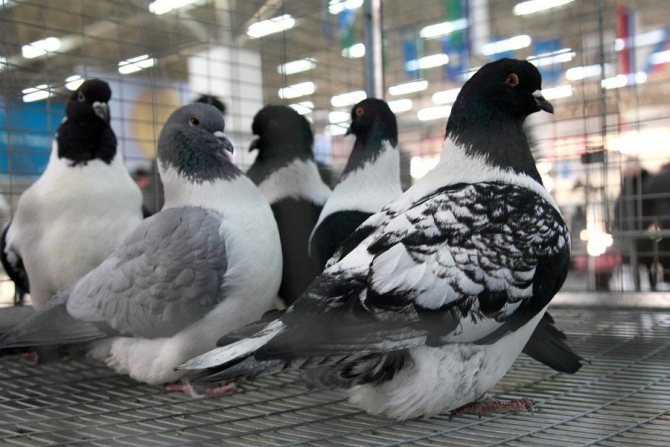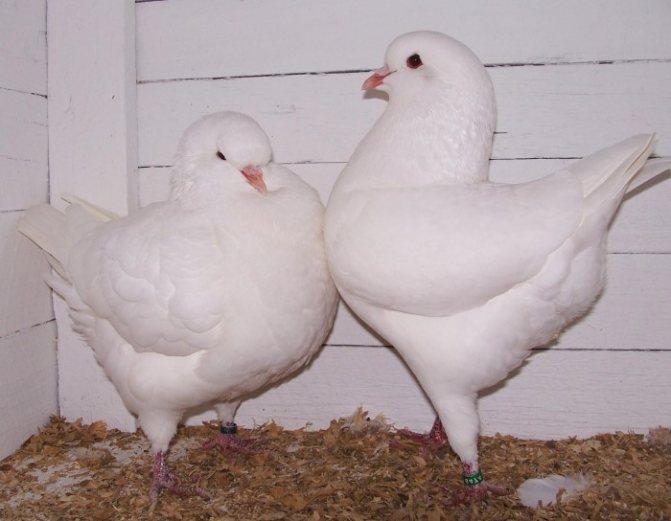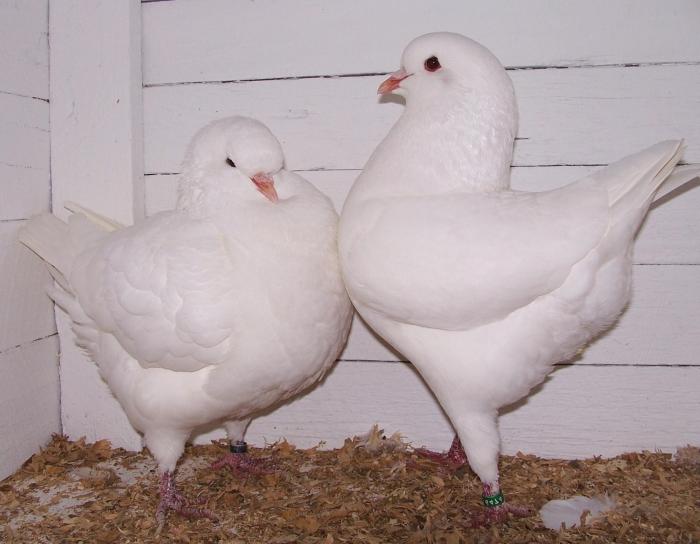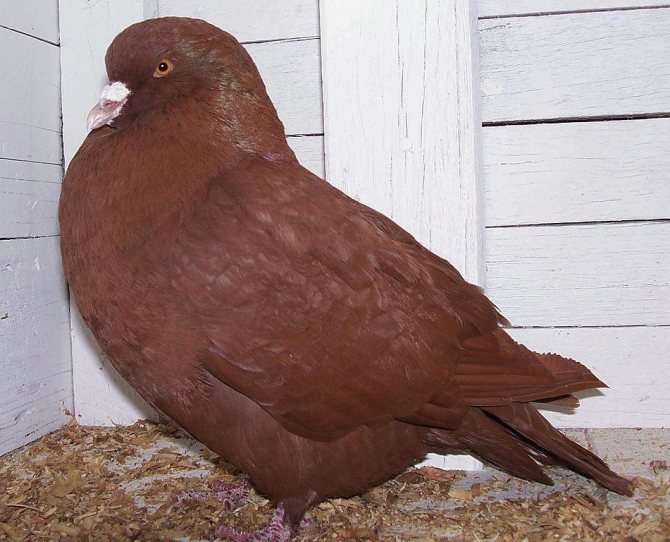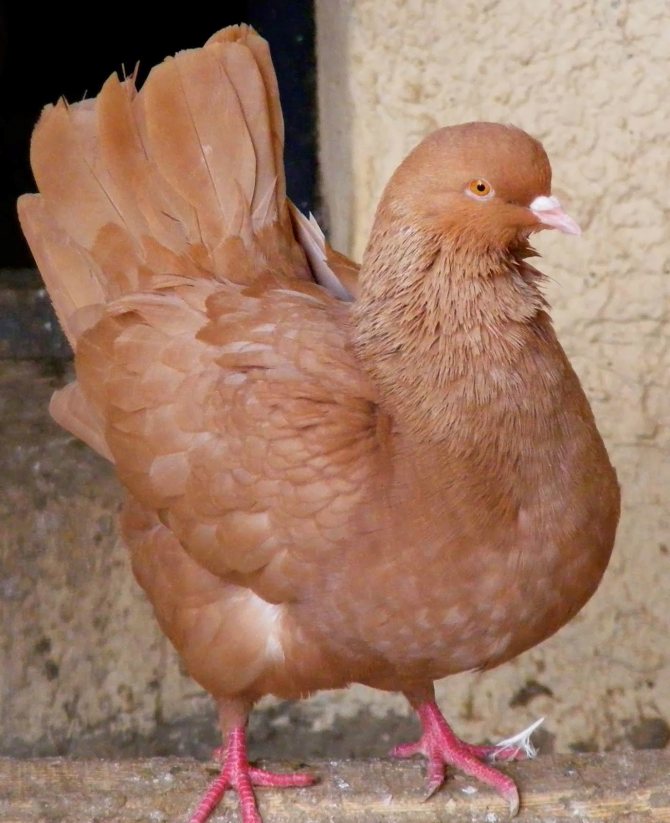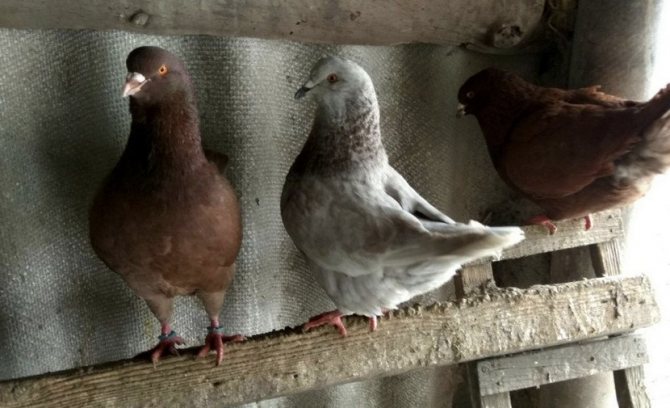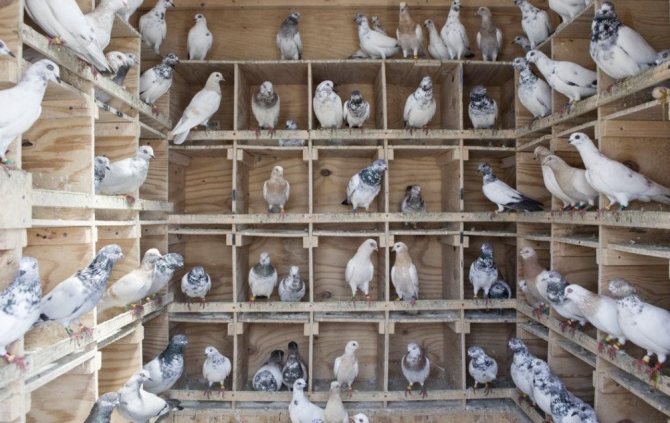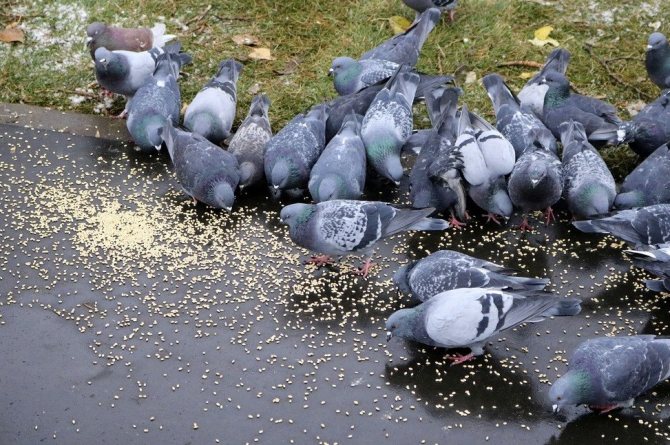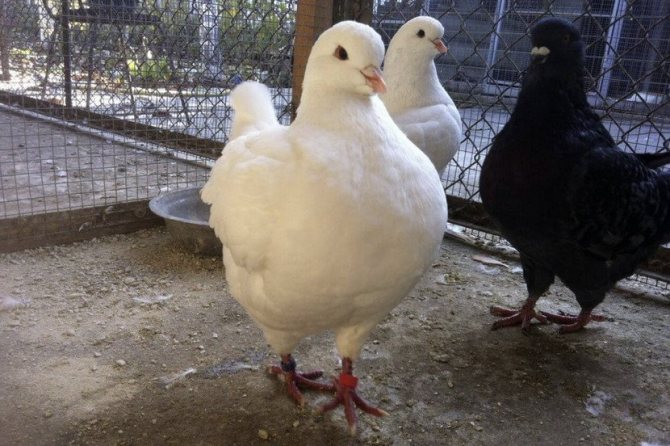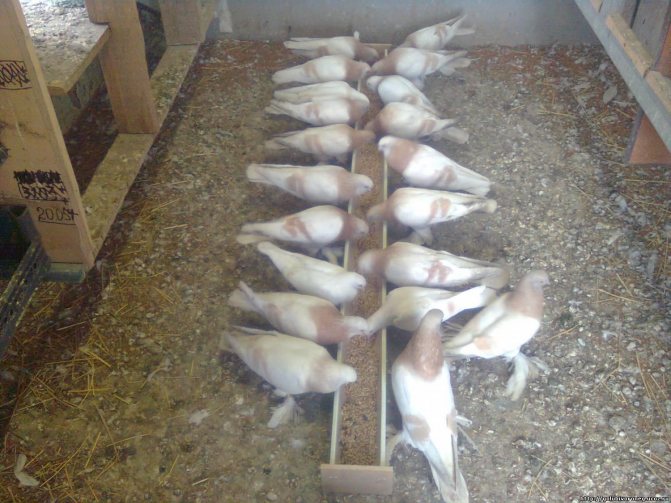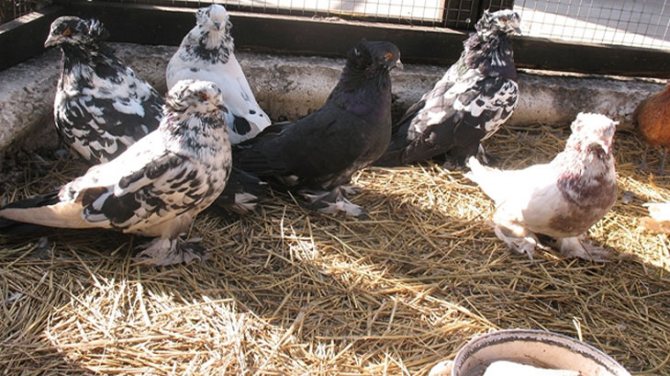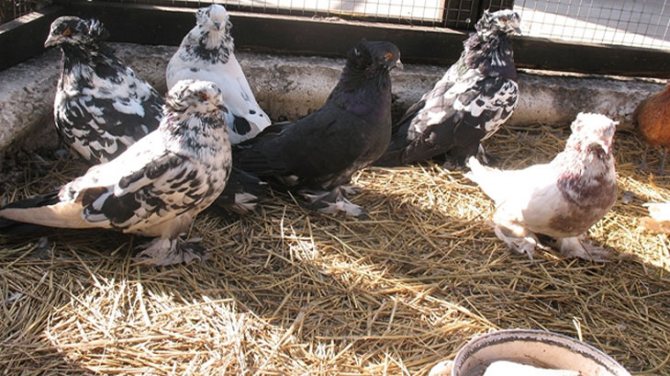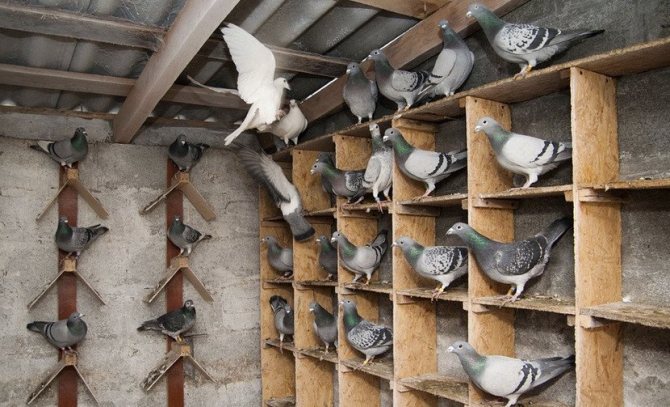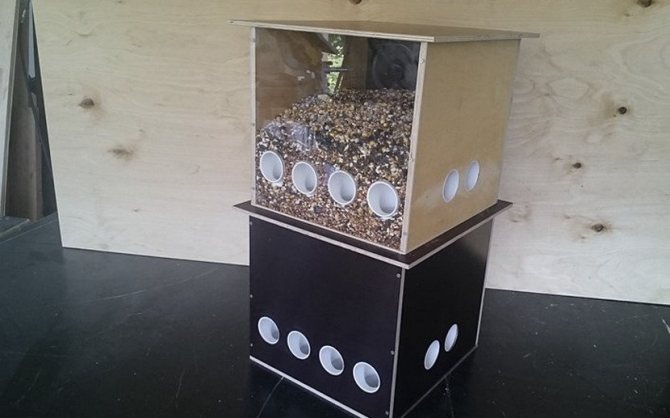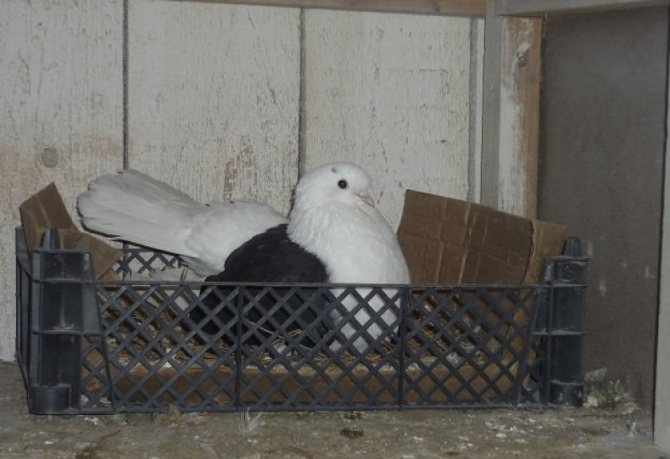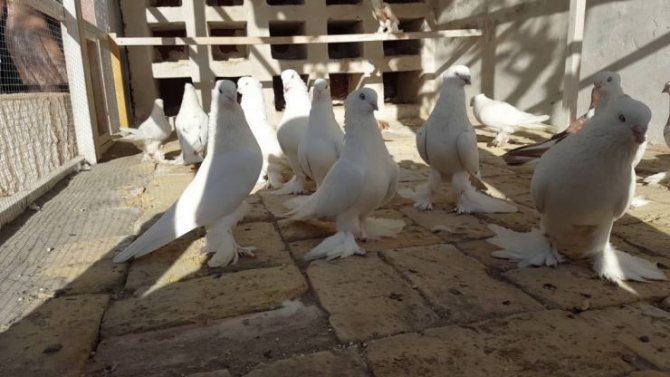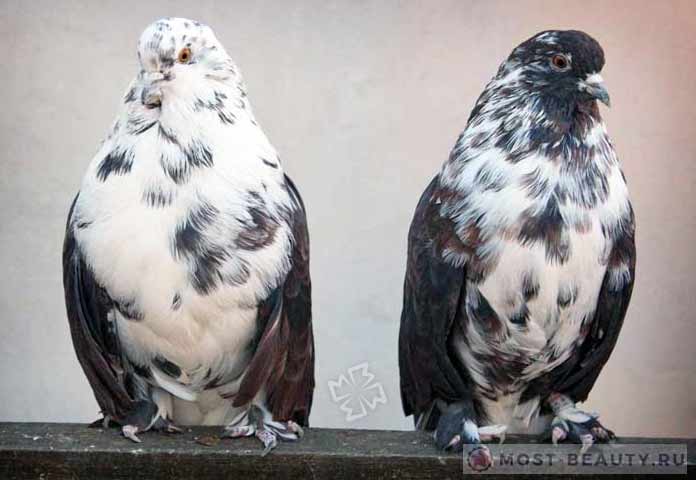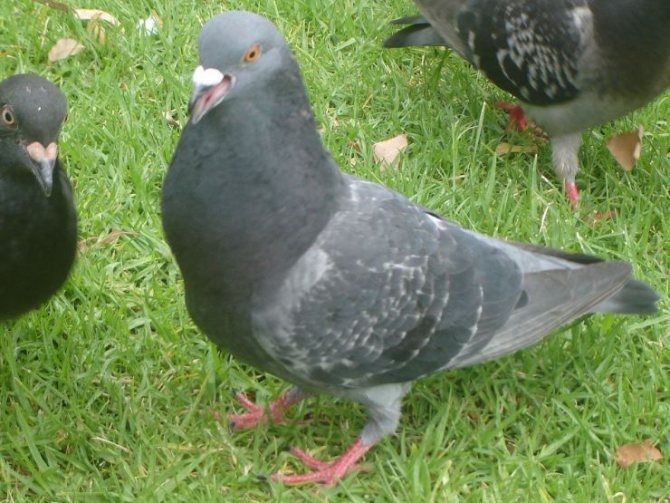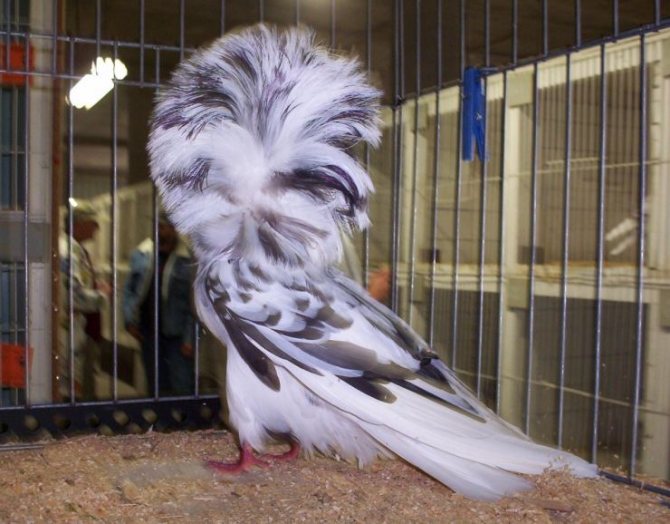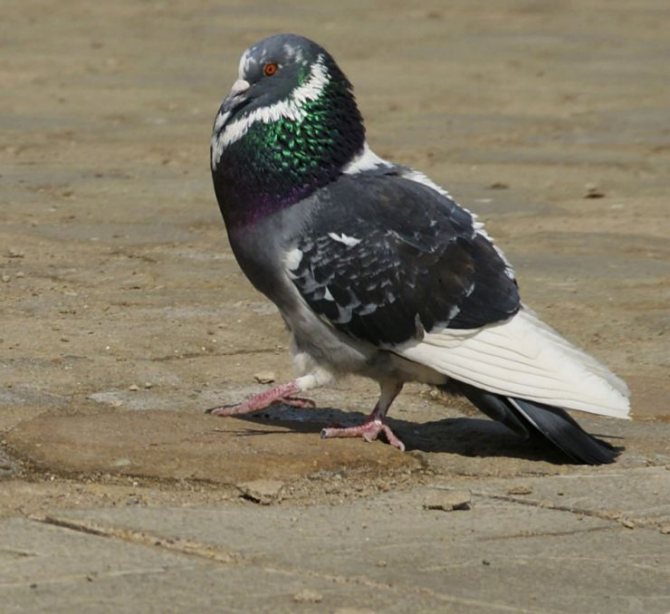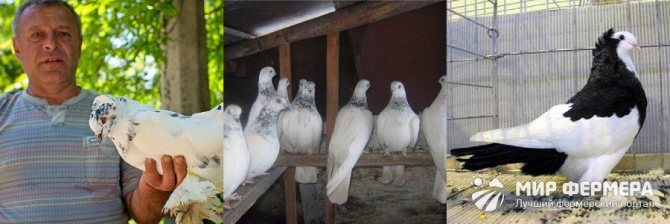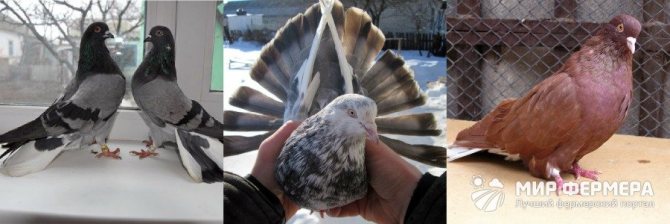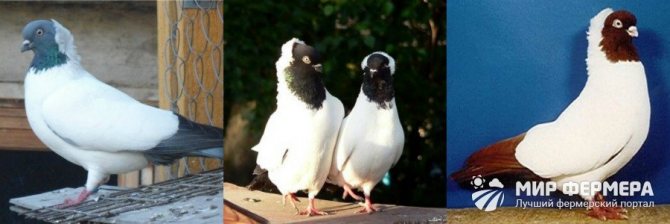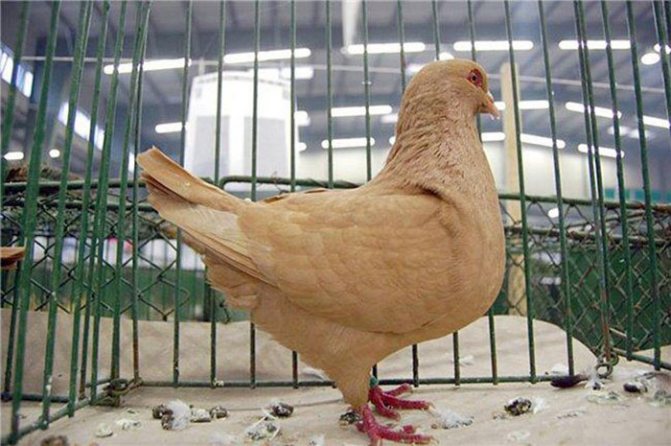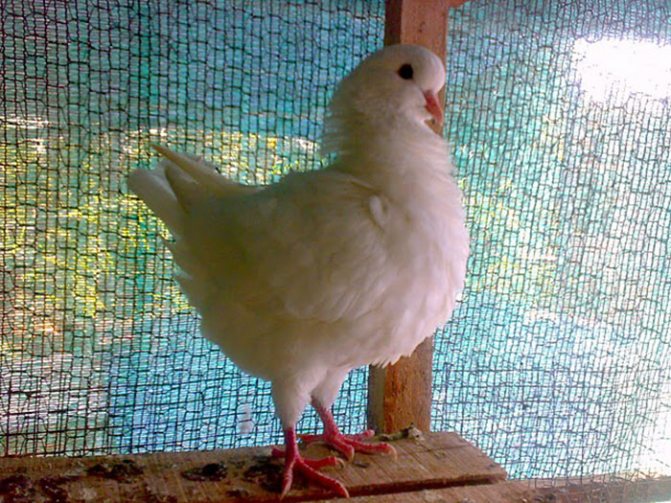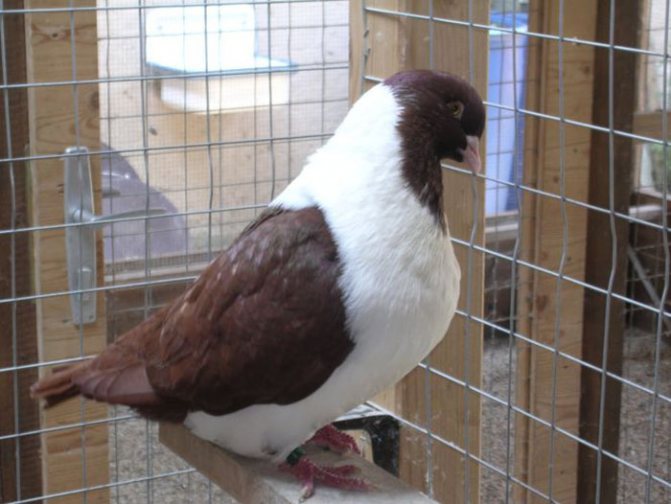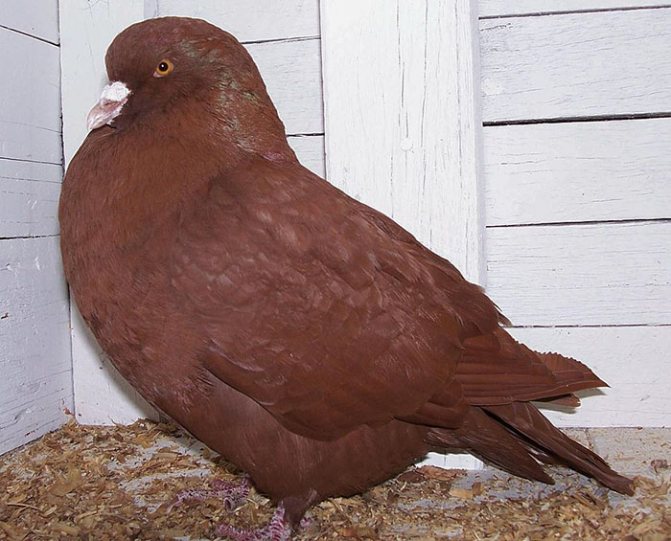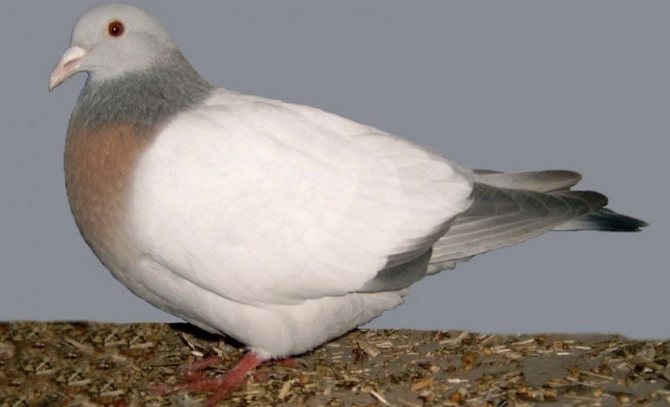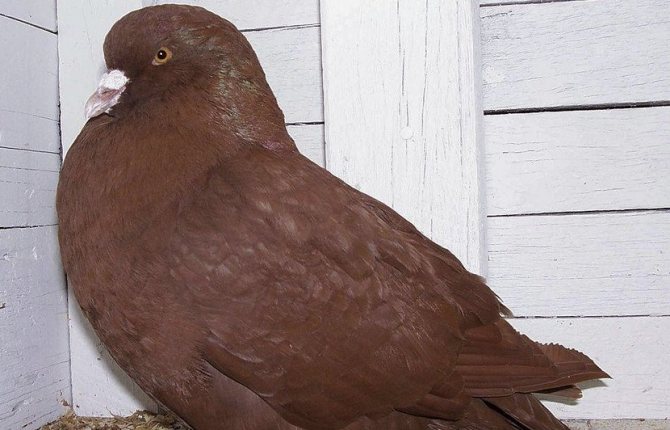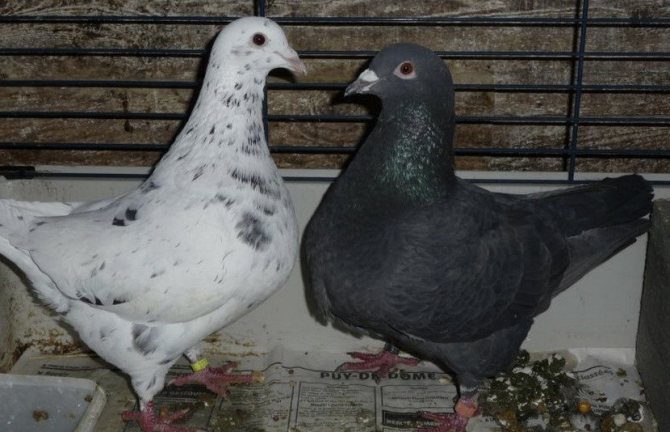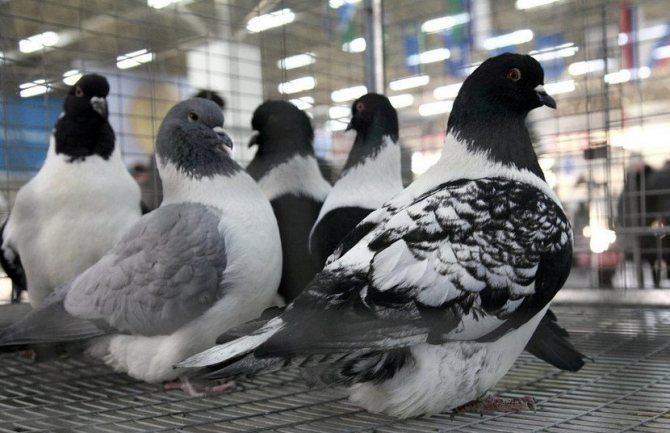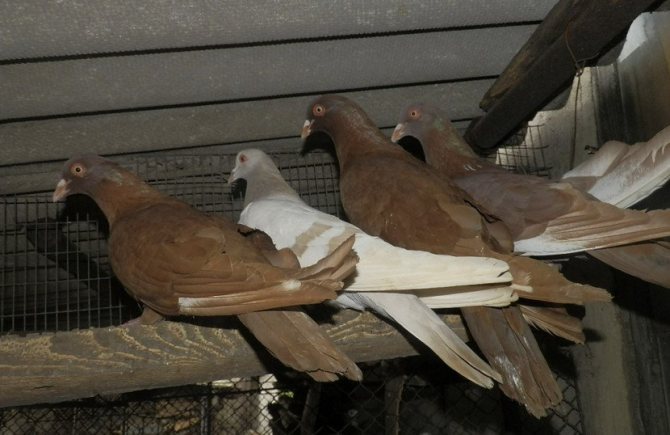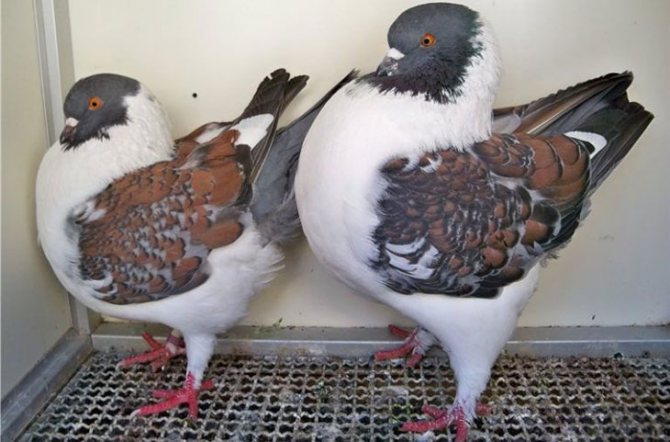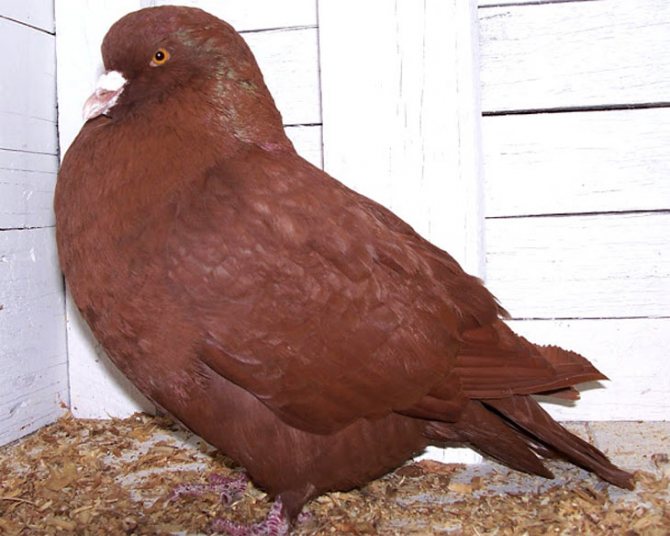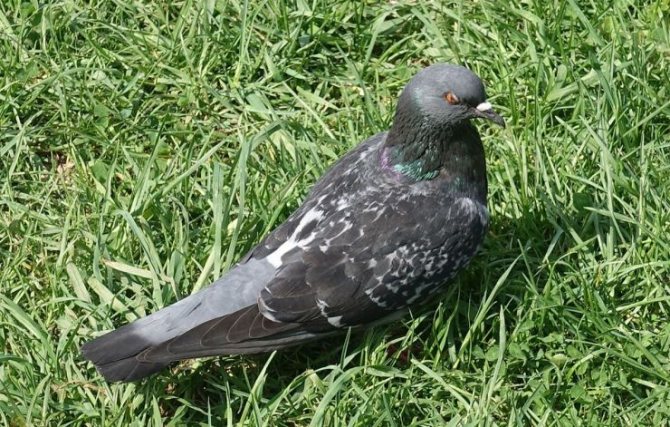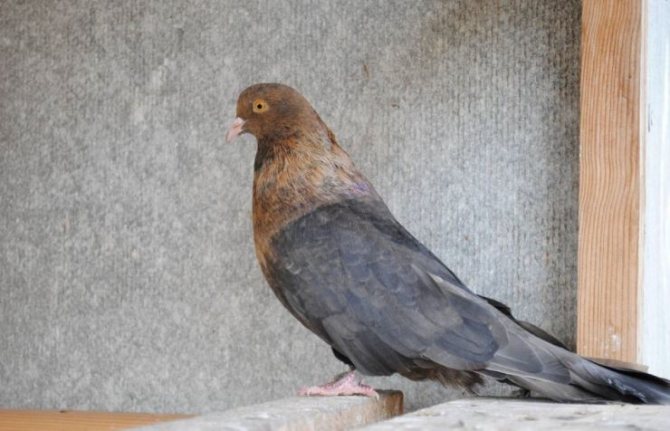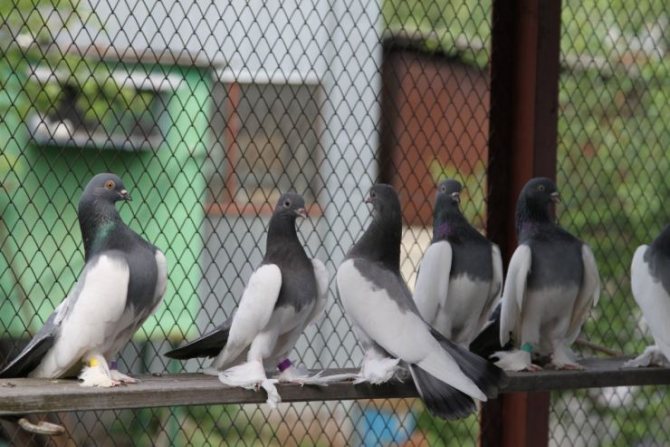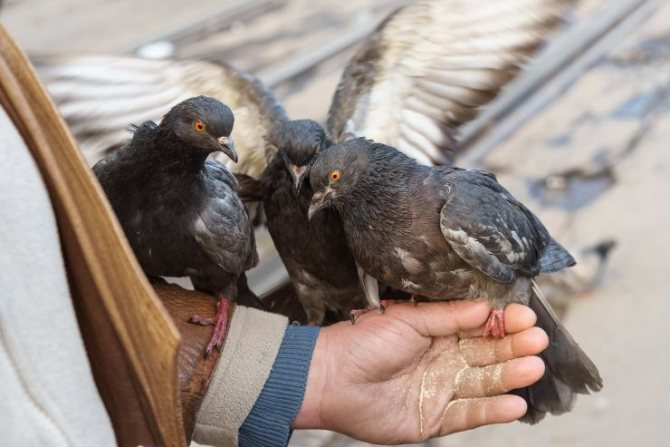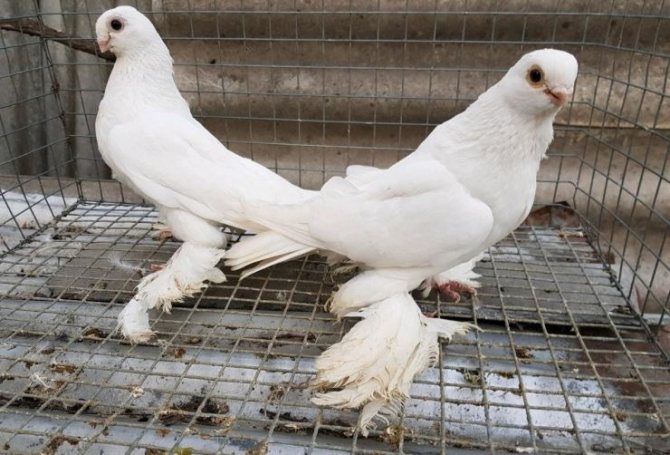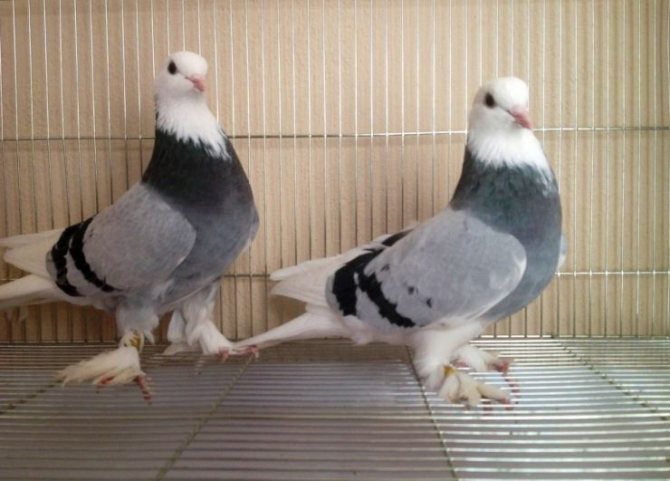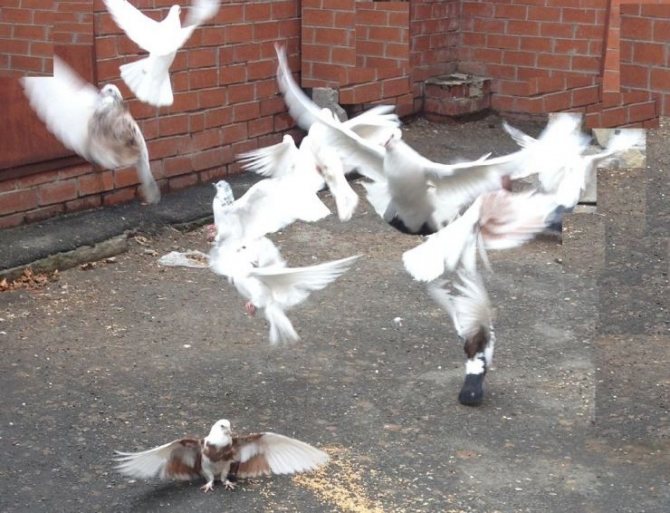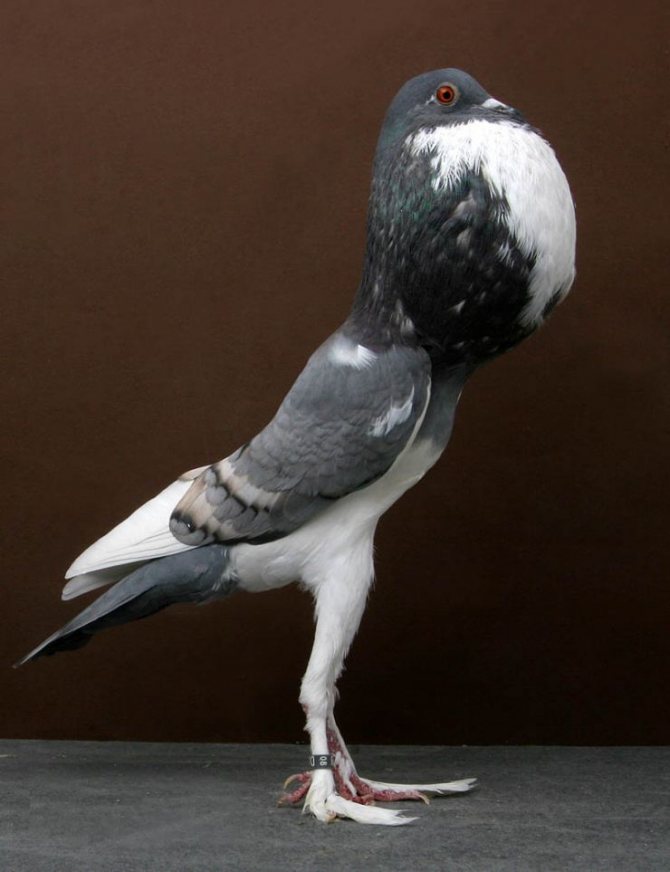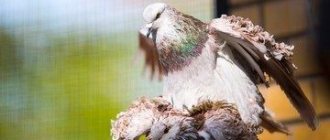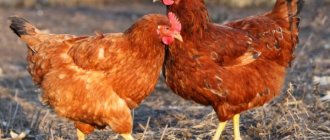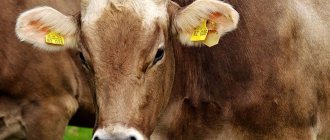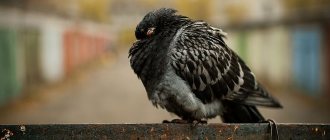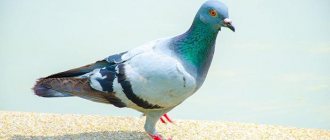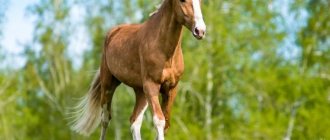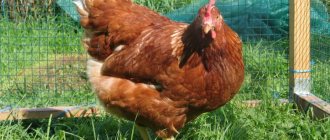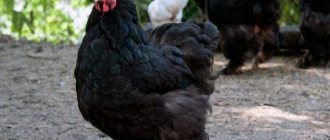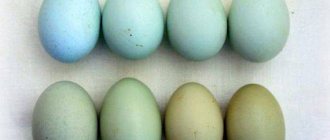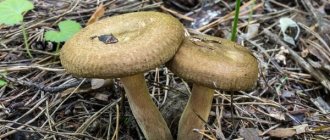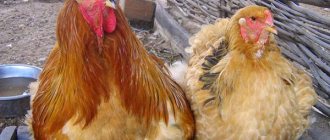People have been breeding domestic pigeons since time immemorial. It is difficult to say where they first began to tame these smart birds, since the habitats of wild pigeons are very extensive.
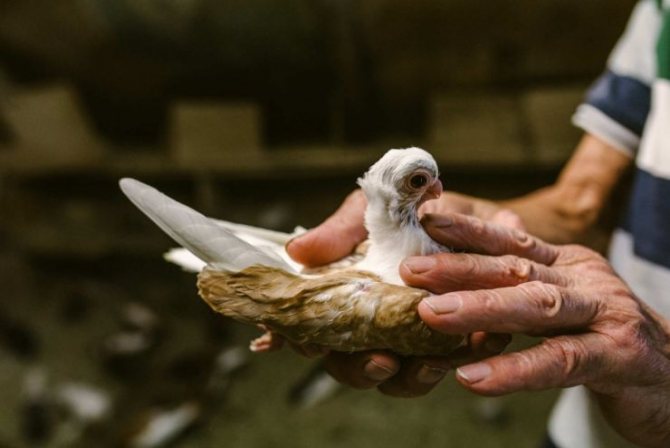
However, images of doves with noticeable signs of selection work were found among the murals of Assyrian and Phoenician buildings, as well as on the walls of the ancient Egyptian pyramids.
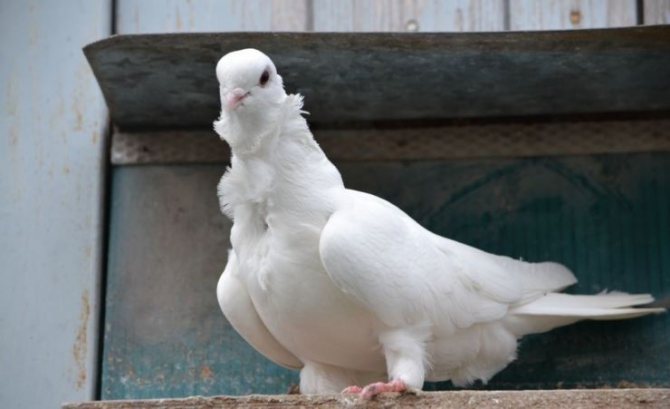

Pigeons are bred for various purposes: for training, participation in sports competitions and exhibitions, certain breeds are grown for the sale of delicious pigeon meat, rich in a complex of vitamins and minerals.
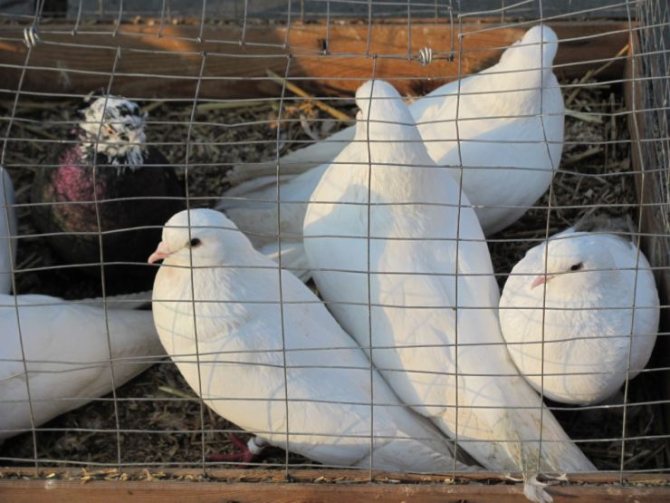

One way or another, breeding domestic pigeons requires special knowledge about the characteristics of these birds and the rules for compulsory care for them.
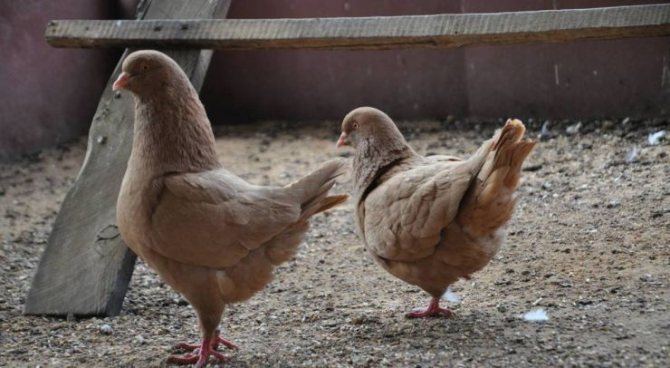

Breeding
Breeding meat pigeons is not much different from other species. The breeding period goes through several successive stages:
- Mating games;
- Pairing;
- Nest filling and arrangement;
- Clutching and incubation of eggs;
- The appearance of chicks;
- Feeding and caring for chicks.
But still, breeding a meat pigeon has its own distinctive features.
After the young are 8 months old, they enter the reproductive period and are bred. Reproduction begins earlier than in other individuals.
Chicks of this breed become completely independent from their parents as early as 1 month. In meat breeds of pigeons, the maternal instinct is well developed. The mass of pigeons is small in comparison with other species.
Reproduction
When breeding pigeons, it should be borne in mind that these birds are monogamous - already established pairs mate. If a female or male is lost, a new pair may not be formed. In addition, they have a well-developed incubation instinct, therefore, as a rule, they do not use an incubator for raising chicks.
King pigeons become ready for mating at the age of 7–8 months. The best egg production is observed in pigeons from one to two years of age. Under adequate conditions, the females make several clutches of eggs (usually 2 eggs in a clutch) per year, and on average 16-18 chicks are hatched during this period. The breeding process is not interrupted even in winter, provided that artificial lighting compensates for the short daylight hours, and the temperature is not lower than 0 ° C indoors.
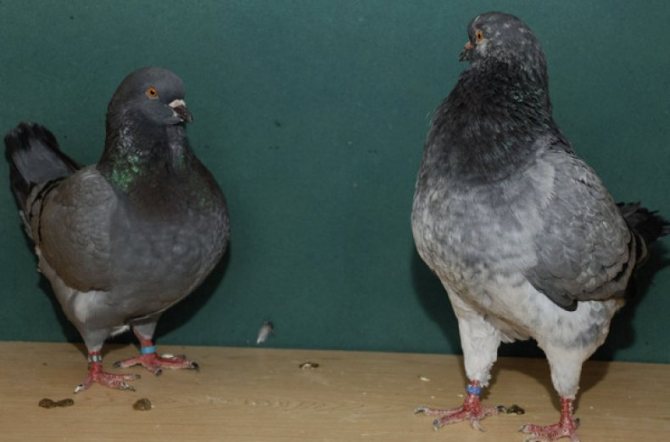

For the king breed, nest boxes are placed on the floor of the dovecote or on a small elevation, as far as possible from each other. In addition, they must not be exposed to direct sunlight. Before the mating season, these boxes are covered with hay or straw.
Parents take care of the hatched chicks completely. As mentioned above, they first feed them with the so-called "bird's milk". From two weeks of age, chicks are able to eat crushed grain. From about 6 weeks of age, the chicks completely switch to self-feeding.
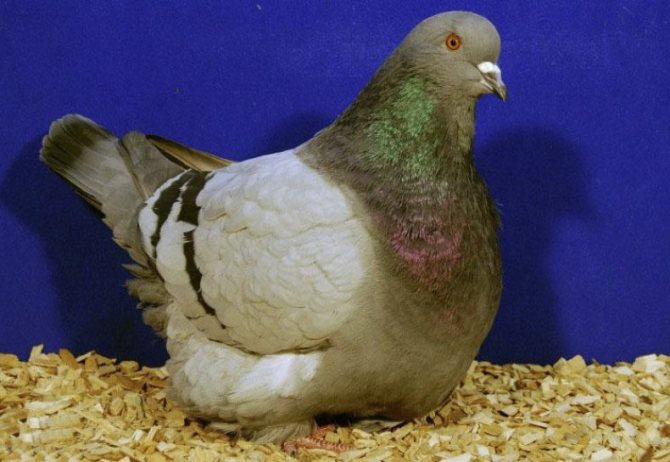

So, we can conclude that breeding king meat pigeons does not present any particular difficulties. In some respects, it is even easier than raising chickens, not to mention more capricious poultry. At the same time, pigeon meat has long been considered a delicacy and can pleasantly diversify home cooking or bring a good income when sold.
Growing methods
There are several of them, and the choice depends on what goals the poultry breeder pursues.
Extensive
It does not require special costs or efforts from the breeder, since in this case the birds get their own food, and the poultry farmer gives them feed once a day so that they can gain weight in the allotted period of time.
This method has several disadvantages. For example, when searching for food, pigeons may encounter wild birds or animals that can carry dangerous diseases. In addition, individuals need to guarantee complete protection from predators. Of course, a well-fed bird that cannot or does not want to fly will become quick prey even for a domestic cat.
Intensive
It involves forced feeding of birds so that they gain 600-800 g and more in weight in a short time. For such purposes, it is better to choose highly productive breeds like King or Texan, since they can increase their mass to a given level in just 30-38 days. In addition, these birds, due to their high fertility, can reproduce offspring 5-10 times a year, which will bring 10-20 chicks to the farm.
Individuals at the age of 3 weeks are suitable for fattening for slaughter, since young meat has the best taste. Selected chicks must be transplanted into a dark room. They need to be force-fed every day up to 4 times a day with a mushy mixture, using special equipment or a syringe without a needle, but with a soft rubber nozzle at the end.
A mixture of cereals, grains and legumes must be prepared as feed. It is recommended to throw mineral supplements into it in small quantities. Each bird should eat 50-60 g of such a mixture per day and wash it down with warm water. The optimal amount of a single serving is 15-20 g. If you feed young pigeons for about 2 weeks, then you can get pigeons weighing about 800 g at the exit.
A combined or economic and decorative method is also distinguished, but it is mainly popular among poultry breeders of domestic decorative pigeons.
Are you here
Why are pigeons and also meat pigeons? Step # 1 I always wanted to keep some kind of living creatures at the dacha, since there are more than enough premises on a rural estate. But there is one very serious thing, but I do not go there every day. I went through a bunch of materials about animals and birds, decided to deal with birds, since animals require the presence of a person every day (except for rabbits). But rabbits are uncomfortable with the danger of a sudden epidemic. As I studied the material on the bird, everything turned out to be not as rosy as it seemed at first: Some need walks, others need expensive automation, others need heating, etc. etc. Incubators, brooders, it turns out that you need to leave everything and deal only with the bird, or do not work at all and not torment yourself, not pets. On one of the forums I read a conversation about meat pigeons, and the idea with pigeons stuck firmly in my head. If you do poultry in your free time, then do meat pigeons. There are a huge number of pluses compared to the minuses. 1. There are practically no competitors on the market. In the process of collecting information about the breeds of meat pigeons, basically all information was reduced to one phrase - "where to get meat pigeons." 2. High price per poultry compared to growing costs. For example, a hunting pheasant costs about $ 15, a pair - $ 30; the simplest industrial lines of the king -50 $ (pair), the Polish lynx - 30 $ (pair). And when you count the costs of raising pigeons and pheasants, the difference is huge. 3. The bird is very resistant to diseases (if properly kept). 4. Does not require heating. 5. Does not require daily presence. 6. Auto feeders and auto drinkers are cheap. 7. Propagates in the presence of glare all year round, except for molt. Any mechanical cheap daily timer can handle the inclusion of the backlight in winter. 8. Pigeons hatch chicks well. No incubators needed. nine.They also excel at raising their offspring without human intervention. Heated brooders are just an unnecessary detail. 10. They don't need animal proteins like chicken proteins. 11. Exceptional taste and dietary properties of meat. Let's face it, there are not many downsides: 1. They are monogamous, a male is required for each female. 2. A small number of offspring per year, on average 12-18 chicks. 3. Small carcass weight. 4. Not all pigeon can be taken as food. Well the cons are actually quite controversial. The first fact is obvious, there is nothing to be done. You can disagree with the second, because a hen hen will grow up hardly more chicks per season. Well, at the expense of the weight of the carcass, there are also smaller birds, the same quails. With the fourth, it is more difficult, in view of the historically formed prejudices. But there are a huge number of amateurs who want to buy not meat, but a live bird. After all, it is birds that are much more profitable to sell than meat. Well, if there are unclaimed chicks, there will be a connoisseur. And you can grill yourself, surprise your friends. Step # 2. Soon after the decision to bring pigeons, the opportunity to purchase four king chicks from the industrial line (the parents were transported from Hungary) turned up. For several days, the kings were in my barn. Since I have not yet decided on the content system. They were simply released onto the floor of the room. I installed a vacuum drinker and the same feeder, fine gravel, chalk. That's all the preparations. A couple of photos of my first pigeons:
Content
The maintenance, cultivation and care of this species does not require the use of complex technologies. Birds can be bred in any equipped room.
The most important thing is that the windows are only in the south, and the air temperature does not drop to minus. Therefore, the pigeon houses must be well insulated.
Pigeon nests must be dry. They must be kept clean at all times. This is necessary according to the rules of pigeon breeding. In the cell space, it can be used as bedding:
- Sawdust;
- Hay;
- Straw.
Disinfection of cells and the entire dovecote is carried out at least once a year. Males and females are very fond of swimming, therefore, in the warm season, they need to equip a special place for swimming.
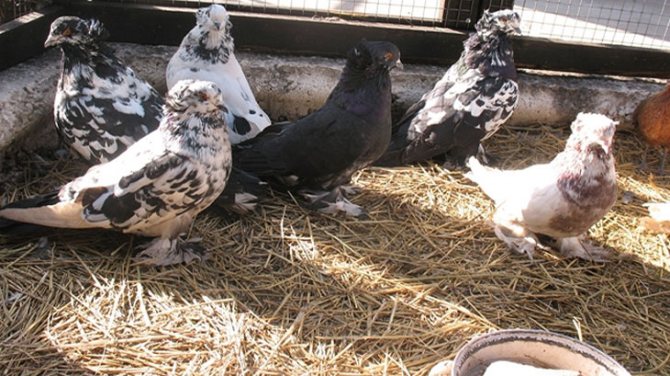

Diet
There are certain features of feeding the meat type of birds. Minerals must be added to bird feed. The diet of birds should consist of cereals and proteins. The dovecote should always have clean drinking water. It is best to equip them with a special convenient drinking bowl. The water in the drinker needs to be changed every day. Slaked lime and eggshells are excellent minerals.
Meat pigeons are easy to breed and care for, and are not picky about food. Compliance with all the rules for breeding this species brings a good income to the owners. Growing beef breeds is a very profitable and challenging business.
Can wild pigeons be eaten?
Wildlife birds are less at risk of disease than urban birds.
Wood pigeon - wild forest pigeon
But remember the events of 2004-2005, when a wave of reports about the avian influenza virus swept through the world media. Pigeons, like chickens, were susceptible to this disease, in connection with which quarantines and the elimination of infected individuals were carried out. In some regions of Russia, whole flocks of wild pigeons were shot.
Wild pigeon
The wild pigeon is a game that can be prey for an experienced hunter. But not every hunter is able to judge the health of a bird by external signs, and even after heat treatment of a carcass, the likelihood of human infection cannot be excluded one hundred percent.
But, despite this, wild pigeons are considered a valuable trophy and a delicious dish on the hunting table. Hunters have repeatedly praised the taste of the meat of turtledoves and pigeons.Usually, soups are prepared from such game or baked in foil over coals.
Based on the above information, it can be concluded that in 85-90% of cases, the meat of wild pigeons is not dangerous to human health, but on the contrary, it is a rather valuable dietary product.
Video - Wild pigeons in their natural habitat
What kind of pigeons do they eat
Meat breeds of pigeons, grown clean, with the correct diet, timely vaccination, have tender meat with the best taste. Individuals no older than two months of age are sent to the slaughter. Their meat is considered the most valuable in terms of nutritional qualities; it can and should be eaten.
As for urban birds, they are not only unsuitable for food, but can also be dangerous to human health. Due to the meager diet and habitat in the city's landfills, wild pigeons are susceptible to infections. In addition, their meat has nothing to do with the juicy, tender meat of poultry.
Wild pigeons are less susceptible to infections, but the possibility of infection when cooking and eating their meat cannot be completely ruled out. For hunters, the wild pigeon is a wonderful trophy, which is suitable for cooking over a fire and soups. The best taste is in the meat of turtledoves and pigeons.
Habitat
For a comfortable stay, birds of this species need a separate warm room and a fenced enclosure for walking. In the dovecote, it is necessary to maintain a certain air temperature (from +5 to + 20C). You can set the desired temperature using thermal insulation.
So that the birds do not have hypothermia, the floor is insulated with straw or sawdust.
During breeding, birds will take part of the litter for nesting. The litter should be changed as soon as necessary, so as not to breed dampness. A complete cleaning of the premises must be carried out several times a year. At the time of cleaning, the pigeons are transferred to a quieter place or outside to an aviary.
The health and reproduction of birds is strongly influenced by daylight. Meat pigeons need walks in the fresh air, sunlight has a beneficial effect on the growth of young animals. Therefore, an equipped aviary for individuals of this species is extremely necessary.
The structure of birds and the size of their wings do not allow them to fly. Because of this, they are forced to equip their nests directly on the ground or floor.
Old german gull
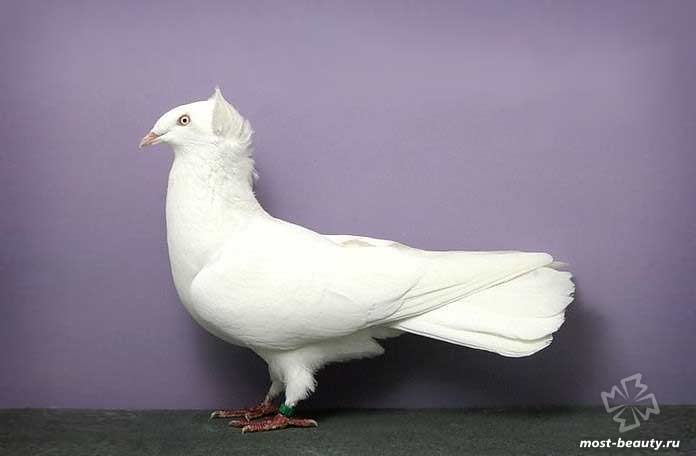

Due to the similarity of plumage color with seagulls, the flight-decorative breed of German pigeons got its name.
This bird is very demanding in terms of keeping and feeding conditions. The breed is very fertile, but the parents themselves cannot feed their chicks, although they do not abandon them. But feeding is done artificially.
To date, birds of the same color have been bred, not similar to the color of seagulls, but the nickname for the beautiful pigeons has survived.
3
Breeding
To breed pigeons in the poultry house, it is required to leave an equal number of males and females so that each individual can find a mate. Under natural conditions, doves make 3 clutches of 2-3 eggs each year. With proper lighting and heating, this figure can grow more than 6 times.
Females can participate in breeding from 8 months, but individuals at the age of 1-1.5 years are considered the most fertile. Mating occurs naturally when pigeons live together in the same enclosure. In this case, you can resort to forced mating if you want to get specific qualities from the chicks. In this case, a couple of pigeons must be temporarily transplanted into a separate enclosure.
It is quite easy to understand that mating has already taken place, and the birds are ready to return to the common aviary, since the pigeons will constantly sit side by side and gently touch each other's feathers.
Eggs are laid after 11-16 days. To make sure that embryos develop in them, on day 6 you can put them on spoons and look at the lumen. If a speck is visible, there will probably be offspring.In addition, with the development of the embryo, the color of the shell changes - on the 8th day, the egg acquires a matte gray tint.
Pigeons alternately plant their eggs for 16-19 days, but in some breeds this period can last up to 29 days. Chicks will be born helpless and blind, but after a few hours they will be able to take food from their parents. During the first 2 weeks, they should eat only goiter milk, and then goiter can already be introduced into their diet, which is softened into the goiter by the parents. Only a month later, good nutrition is permissible.
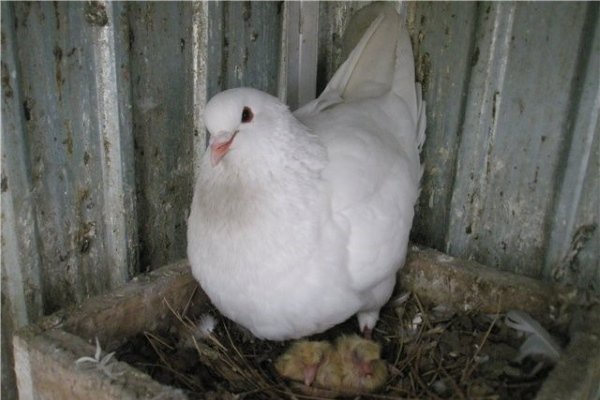

Pink-headed speckled pigeon
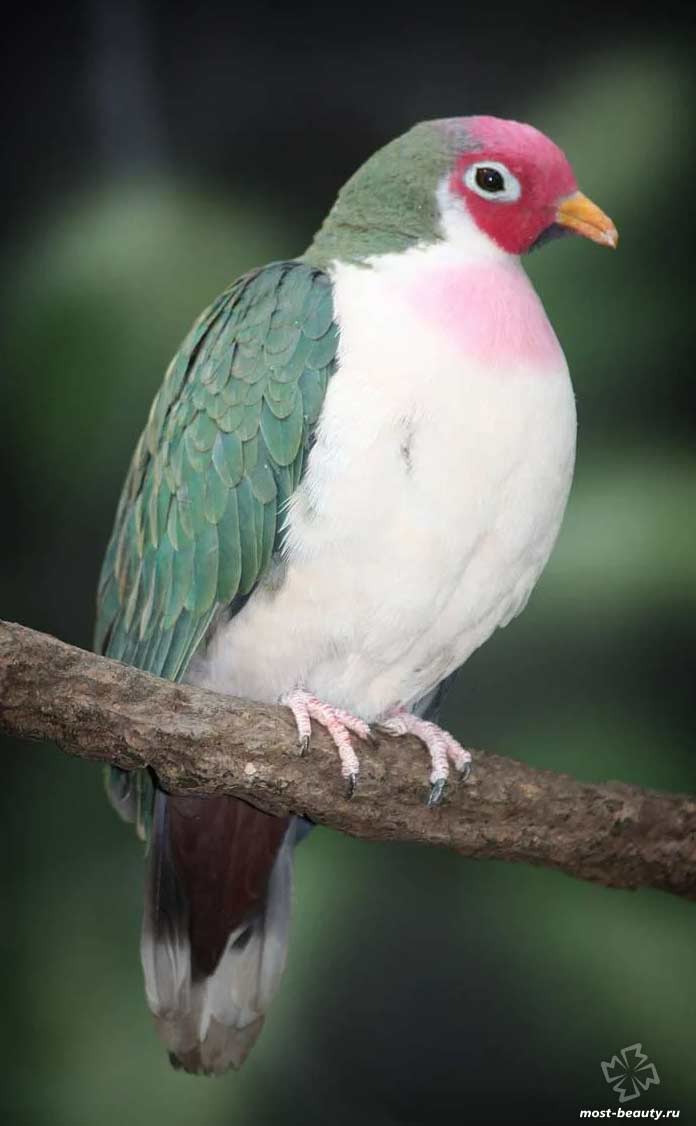

This exotic and beautiful pigeon lives only in Southeast Asia and does not want to live and produce offspring in captivity at all.
The pigeon has a peculiar color. The face is bright pink, only the back of the head is green. Wing and tail feathers are also green.
Interestingly, the eggs are hatched alternately by two parents. And the pink-headed pigeon feeds only on fruits, picking them both from the branches and picking up fallen berries from the forest floor.
6
Features of the content of meat pigeons
Many poultry farmers keep pigeons in the attics of country houses or build separate poultry houses for them. In any case, the room must be under a canopy, protected from temperature extremes, and suitable for summer and winter keeping. It is equally important to have good ventilation and heating.
To ensure acceptable conditions for keeping birds, it is worth equipping the dovecote as follows:
- execute windows that should face the south side;
- place nests on the floor or on a low elevation, since most meat breeds fly very poorly;
- provide nests with paths along which individuals can climb;
- spread the floor and constantly monitor its cleanliness (at least 2 times a year, you need to disinfect the bedding);
- install drinkers and feeders that need to be refueled on time.
In the dovecote, the air temperature must always be kept above 0 ° C
Pigeons checked by a veterinarian can be launched into a prepared poultry house. Basically, they need to be fed with cereals, but rye, oats and lupine should be completely excluded from the diet. A feed mixture can be prepared from the following ingredients:
- corn (35%);
- barley (20%);
- peas (20%);
- oatmeal (15%);
- greens (5%).
It is imperative that the diet must contain vitamin and mineral supplements (5%), which can be added to the feed:
- lime;
- river sand;
- chips of red brick;
- clay;
- charcoal;
- shells from eggs.
Individuals of meat breeds should consume about 50-55 g of grain mixture per day. Of course, they should not be fed spoiled or moldy food as it will be difficult to digest.
It is equally important to ensure that there is always fresh water at room temperature in the house, since birds cannot live a day without life-giving moisture. If feathers, bird droppings or small debris get into the water, then it must be immediately poured out, and new water must be poured into the drinkers.
In order for pigeons to be completely healthy and have strong immunity, it is necessary to vaccinate them 2 times a year using the services of a certified veterinarian.
Disease prevention
King pigeons are very resistant to various diseases, but nevertheless they can also become infected with any disease characteristic of this bird: twirling, pigeon pox, psittacosis, paratyphoid fever, salmonellosis, etc. Preventive measures of a general nature include the following actions:
- creating comfortable conditions for poultry;
- periodic cleaning of the dovecote (including feeders and drinkers), twice a year you need to carry out its general cleaning with disinfection;
- at least a week's quarantine for new pigeons;
- exclusion of contact with wild pigeons, sparrows and in general with any wild bird;
- periodic examination of birds in order to identify symptoms of diseases.
In addition, various medicines are used for prophylactic purposes. So, deworming (getting rid of worms) is carried out a month before the breeding season with garlic or special preparations such as Levavet or Tetramisole.
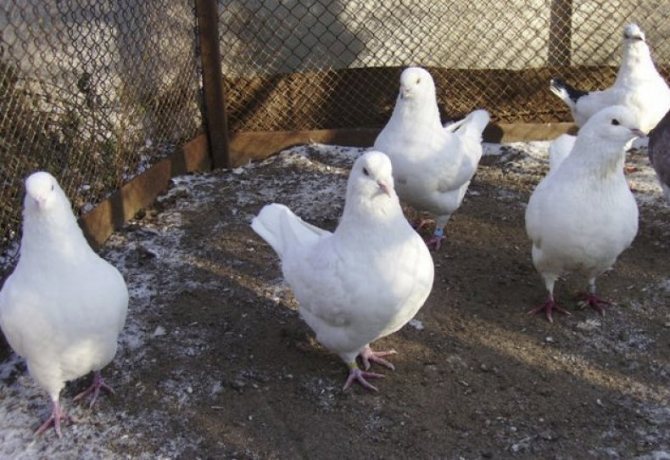

For general strengthening of immunity, use "Fosprinil". If there is a high risk of spreading the infection, the bird is given antibiotics, "Enroflon" or "Enroflox". The dosage and duration of use of the above funds is prescribed in the instructions for their use.
Hungarian giant breed
A giant, then, is huge. The Hungarian giant stands out from other meat pigeons in terms of its size. The weight of the male can reach 1.2 kg, the female 850 g. Fertility in a married couple, in comparison with other breeds, is low, 10 chicks per season. Giants can be recognized by the following features:
- the head is large, decorated with 2 tufts; eyes with a red tint; beak of medium size, dark;
- the neck is short; behind the plumage, it is poorly defined; has no bends;
- birds have a vertical landing; the back is elongated, straight: forms a straight line with the neck and tail;
- the chest protrudes forward, but it is inconspicuous; the chest, like the back, is wide, powerful;
- limbs are short, covered with long feathers;
- metatarsus well developed; they have long hair on them;
- the wings are pressed to the body, gather on the tail;
- feathers on the tail are straight; the tail is narrowed;
- plumage is bright, variegated; white and brown feathers form a pattern.
More on the topic:
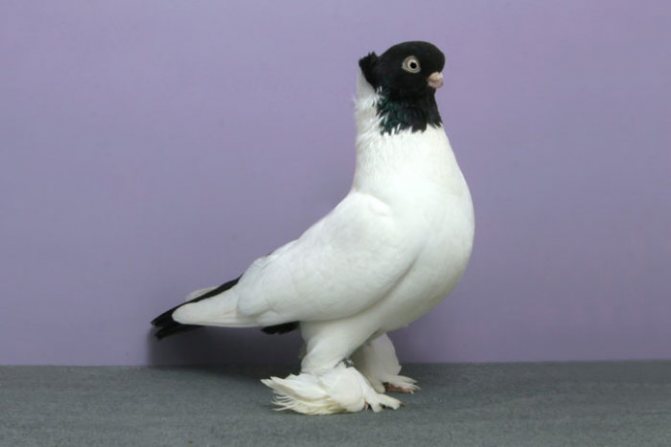

What are the most beautiful pigeon breeds?
Giants are often used as a decorative bird. Those individuals that have not passed the breed standards are used for meat. Pigeons are kept in an aviary or in spacious cages with high shelves. The steam is 2 m3.
Strassers
A bird with original plumage and weighing up to a kilogram. Large body with a large head and large forehead, medium dense curved neck. The protruding roundish chest is an adornment of this bird, but the back is short, but wide. The wings completely cover the dorsal part and end at the tail. The unfeathered legs are of medium size, scarlet and wide apart.
Strasser pigeons have all sorts of colors, some with a belt on the wings and tail. There are white-winged and white-tailed strassers among the strassers.
Strassers are violent, they often fight and fly badly. The fertility of the breed is high, and the genetic potential made it possible for the industrial breeding of the breed. An adult female weighs about 700 g, and a male up to 1000 g.
With purebred breeding, the indicators are much higher than when paired with other breeds. To prevent a drop in productivity, females no older than six years of age are allowed to breed.
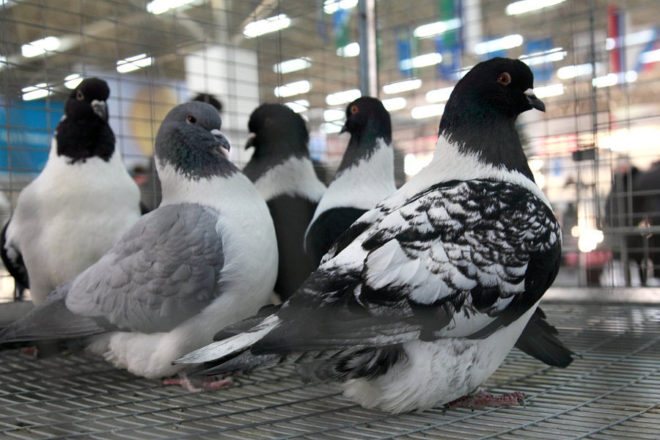

Strasser pigeons are heavy, reproduce well, but have a violent disposition.
French breed
Carnot pigeons were bred by breeders from France. The breed is especially revered by poultry breeders. The bird is able to exist in cramped conditions. She does not need spacious enclosures. For 1 individual, 0.5 m3 is allocated. Carnot has its own distinctive features:
- the head is small, without a forelock. The eyes are small, dark;
- beak pink, long, slightly curved. The wax is bright white;
- the neck is short, without bends, but the transition to the chest and back is smooth;
- the back is wide, long;
- the chest is muscular, protruding forward. Carnot looks voluminous;
- the wings are long, tightly pressed to the body;
- the tail is short, smooth. Consists of feathers of different lengths;
- plumage dense. The color can be yellow, black, white;
- the limbs are covered with short down. Metatarsus remain without plumage. Their color is red;
- the male weighs 700 g, the female 600 g. Poultry farmers are attracted by the accelerated weight gain of young animals;
- the female lays 16 eggs per season. The survival rate of chicks is high.
Carno has well developed wing muscles, but he flies poorly.When keeping a flock in an aviary, the wings of individuals are not cut off, and high hedges are not made. Fencing is not necessary to protect the flock from pets.
Carno has good immunity. Pigeons are not vaccinated. Cellular content contributes to a decrease in infection of individuals and a better weight gain. It is recommended to protect them from communication with wild birds.
Description of King birds
King pigeons have predominantly white plumage (there are species in which the color of the feathers varies to golden brown or black), a thin skeleton, a small wingspan and a massive body. Their mass is usually equal to 600-800 grams, but in some cases it can reach 1.5 kg.
A detailed description of the subspecies of this bird shows what is its superiority over other subspecies. Kings possess:
- well developed and rounded chest;
- small black or yellow eyes;
- powerful beak;
- short feathers;
- strong paws of medium length without plumage;
- short tail;
- wide back.
This subspecies is quite aggressive and is a low-flying species. The plumage color can range to milky, golden, coffee or silver.
External beauty, as well as the ability to quickly adapt, makes this breed especially in demand, but keeping it with other breeds is not recommended.
Can domestic pigeons be eaten?
If the domestic pigeons are healthy, vaccinated and have sufficient live weight, and you have a desire to taste their meat, then you can cook the birds and serve. Most often, large individuals go to slaughter, which are rejected for external signs and have no value for the breeder. But breeders of decorative domestic pigeons almost never eat the meat of their pets. It is not only about affection and humane attitude towards birds, but also about the fact that the meat of an adult bird is quite tough and dry, and the chicks of decorative breeds at the age when it is necessary to slaughter, do not have time to gain weight.
Young meat breed king
In order to be able to enjoy dishes from low-calorie and healthy poultry meat, special "meat" breeds of pigeons were bred through complex selection work.
Pigeon meat quality
The meat of these birds is with fine fibers, it contains a large amount of proteins, and it tastes better than chicken. Its taste and appearance are similar to game meat.
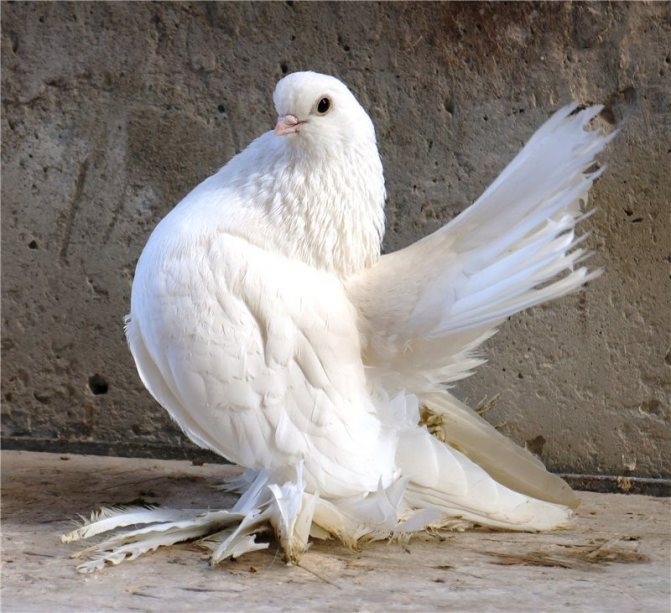

Meat pigeons vary in weight of adult birds. Moreover, the males of the king variety were recognized as the best in terms of meat indicators. But at about 4.5-5 weeks, many beef breeds lose weight. This happens because at this age they fly out of their nests, starting an independent life.
Breeding methods for meat pigeons
Meat pigeon breeding did not become widespread in our country, although in the 70s in the Odessa region there were attempts to open workshops for the production of pigeon meat. However, they were unsuccessful.
In European countries, in particular in Hungary, where meat pigeon breeding is well developed, several breeding methods are used. Among them: extensive, intensive cultivation and combined (economic and decorative).
Extensive method
This breeding method is considered quite costly. But for breeders living in regions with a warm climate and having free access to green food, the method is quite applicable. Birds have the opportunity to independently obtain food for themselves in the summer, and the breeder feeds the pigeons once a day. On the one hand, this is a fairly economical way of breeding, but on the other, difficulties are associated with the fact that pigeons need to be protected from predators, wild birds that can carry infectious diseases. The main thing is that there is no guarantee that in the allotted period of time the pigeons will have time to gain a certain mass.
Intensive method
The intensive breeding method is characterized by regular feeding, which is aimed at a rapid increase in weight. For this method, the most suitable breeds such as Texans, Kings. They are able to gain weight in a month. In addition, these breeds are fertile and capable of making about 5-10 clutches per year.
Attention! It is advisable to select chicks for fattening no older than three weeks of age, since their meat has the best taste.
Selected meat pigeons are planted in cages and forcibly fed with a mushy mixture 4 times a day at a certain time. Each individual absorbs about 50-60 g of this mixture per day. In 2-3 weeks, pigeons gain up to 800 g.
Of the minuses of such content: the risk of developing some pathologies is possible, since the bird is in limited conditions of detention. The meat of these birds contains a high percentage of fat.
Combined method
Most common among lovers of meat breeds. Represents a cross between intensive and extensive breeding method. Suitable for those breeders whose main purpose of breeding is to make a profit.
Description of King pigeons
Until recently, Kinga pigeons, used only in cooking, today adorn bird exhibitions and fairs. This breed was bred from the parent Vikings and Post, and to this day it does not lose its popularity among poultry breeders.
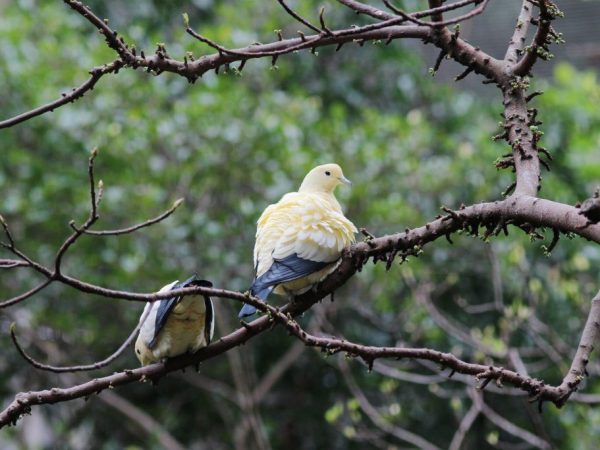

King pigeons
There is a lot of writing and debate about the benefits of pigeon meat and the peculiarities of growing the King breed. This species of birds has caused a resonance among farmers and owners of large farms.
Chinese seagull
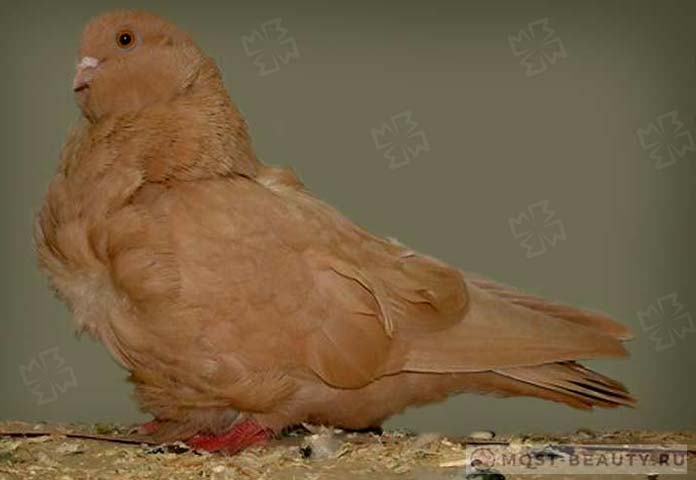

Another breed of pigeons, with their plumage color resembling a seagull, but now Chinese. But this pigeon was bred not in China, but in Africa. From the African continent it was brought to Europe, where it became extremely popular among pigeons.
Slender, with a proud bearing, the birds have magnificent plumage. Chinese gulls are excellent flyers. They are unpretentious in keeping and feeding.
The rich color of the plumage gives the pigeon of this breed a luxurious and unusual look. Plumage colors can be different: from white to golden. Sometimes specimens are born with different color combinations.
13
Red-necked motley pigeon
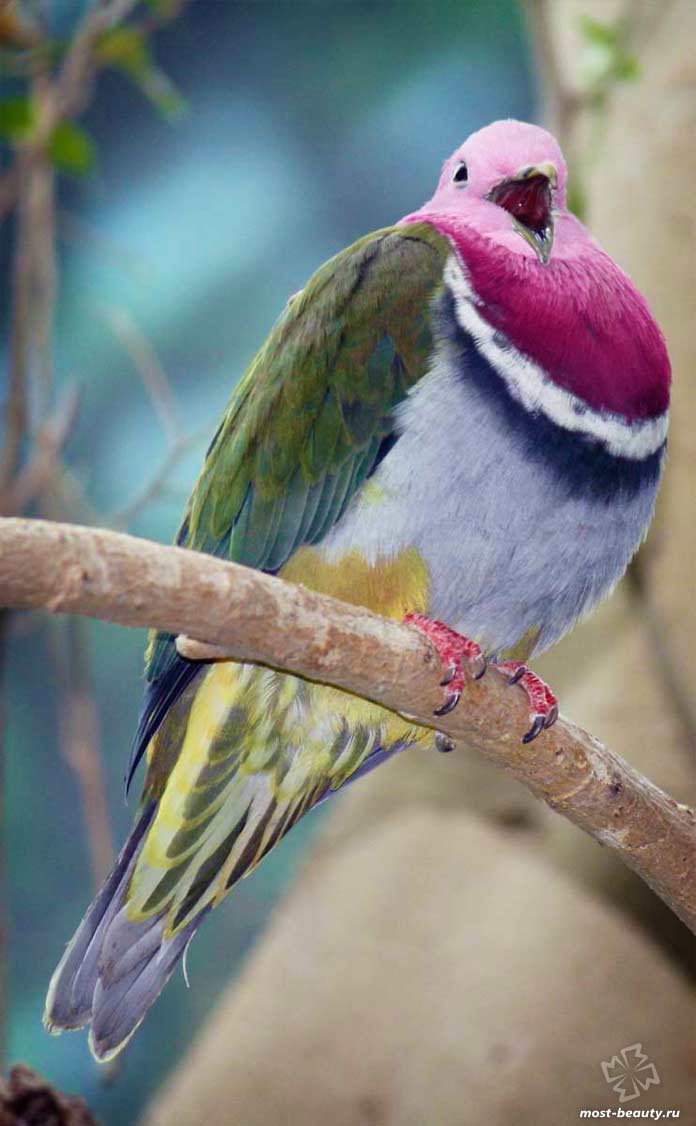

Photo by: / wikipedia.org.
The purple-pink neck, head and chest of the pigeon give the name to this species of the diverse family of pigeons. The rest of the body is gray with olive tints.
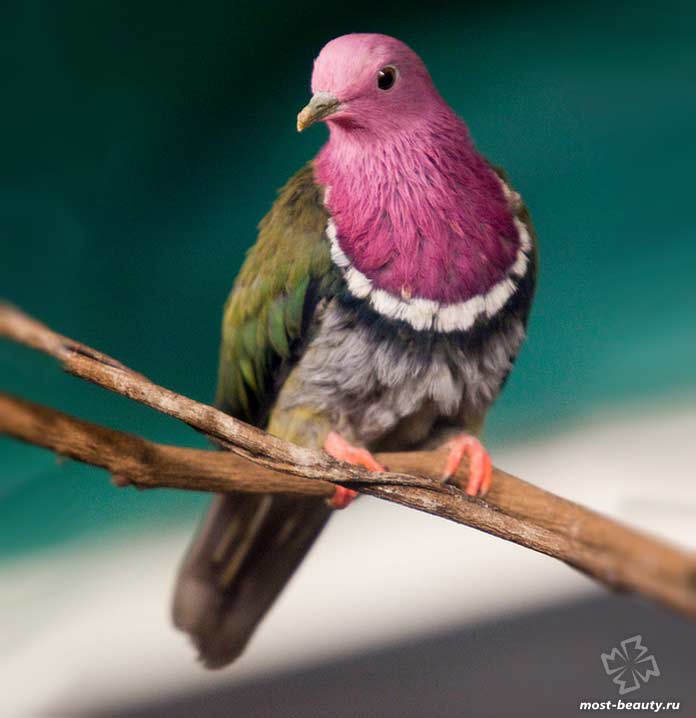

Like many relatives, the red-necked pigeon nests in Southeast Asia. This mod and dandy can be found on the branches of the tropical trees of the islands of Java, Sumatra and Bali.
The pigeon nests its nests high in the trees and very rarely descends to the ground.
10

